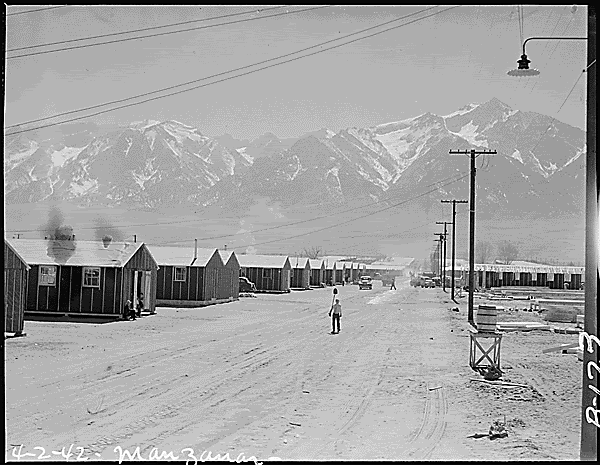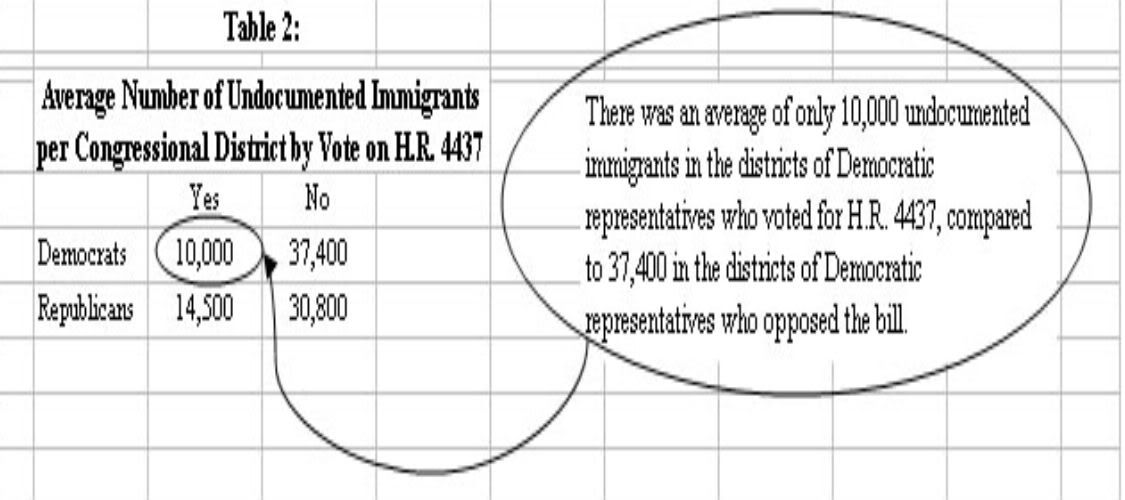Internment of undocumented immigrants to begin.
On Tuesday, Homeland Security Secretary Michael Chertoff announced that DHS would be opening detention facilities in the next few weeks to house thousands of Chinese immigrants who have been denied immigration to the United States, yet were refused readmission by the Chinese government. Currently there are an estimated 39,000 undocumented immigrants caught in this diplomatic limbo, but if the more punitive immigration legislation passed in the House back in December, and now being debated in the Senate, was to become law perhaps millions more would join them.

The Department of Homeland Security's decision to end the "catch and release" immigration policy by Oct.1 comes on the heels of last month's announcement by the Army Corps of Engineers that a $385 million contract had been awarded to Halliburton subsidiary Kellogg Root and Brown to build "temporary immigration detention facilities".
As the Senate Judiciary Committee takes up immigration reform this week they will be debating provisions that may increase the number of incarcerated undocumented immigrants into the millions. Both the current Senate proposal, "The Comprehensive Immigration Reform Act of 2006", sponsored by Sen. Arlen Spectrer, and it's House equivalent, the "Border Protection, Antiterrorism and Illegal Immigration Control Act of 2005"(HR4437) would criminalize almost any immigration infraction and leave the entire undocumented population vulnerable to incarceration. Both bills, in theory, call for the arrest and possible detention of all undocumented immigrants.
With the internment of undocumented Chinese immigrants and their families becoming a very real possibility, we need to start to look at the real ramifications of some of this proposed legislation. Homeland Security has already announced its intent to greatly increase the incarceration of undocumented immigrants and Halliburton is ready to supply the facilities to hold them. With HR 4437's provisions for indefinite detention and the reclassification of even minor offenses as aggravated felonies it is quite possible that all 12 million undocumented immigrants in this country could shortly end up in internment camps no different from the refugee camps we see throughout the rest of the world. We just never thought it could happen here.
Tag: immigration
-Read Full Story-
In an interview with The Associated Press, Chertoff said that China last year readmitted 800 people. But that made only a small dent in what he described as a backlog of thousands illegally in the U.S.
"The math is pretty easy — at that rate, we wind up with increasing numbers of migrants who, if we're going to detain them, we're going to have to house at enormous expense," Chertoff said.
He added: "We can't be in the position any longer where we are paying the burden and bearing the burden for countries that won't cooperate with us and take their own citizens back."
The Chinese Embassy in Washington did not immediately return a call for comment.
Currently, 687 Chinese are being held in federal detention facilities, at a daily rate of $95 each, while some 38,000 have been released on bond or under a monitoring program, such as wearing an electronic surveillance bracelet, the Homeland Security Department said later Tuesday.
-snip-
Chertoff also said Homeland Security would open detention facilities in the next few weeks to house entire families of illegal immigrants who hope to bring their children along in order to avoid jail time. "It'll be humane, but we're not going to let people get away with this," he said.
Chertoff's remarks comes as the Homeland Security Department aims to end its "catch and release" immigration policy by Oct. 1. After that date, all illegal immigrants will be held in U.S. detention centers until they can be returned to their nation of citizenry.
AP

Japanese-American internment camp during WWII
The Department of Homeland Security's decision to end the "catch and release" immigration policy by Oct.1 comes on the heels of last month's announcement by the Army Corps of Engineers that a $385 million contract had been awarded to Halliburton subsidiary Kellogg Root and Brown to build "temporary immigration detention facilities".
Halliburton Subsidiary Gets Contract to Add Temporary Immigration Detention Centers
New York Times
Feb. 3 - The Army Corps of Engineers has awarded a contract worth up to $385 million for building temporary immigration detention centers to Kellogg Brown & Root, the Halliburton subsidiary…
KBR would build the centers for the Homeland Security Department for an unexpected influx of immigrants, to house people in the event of a natural disaster or for new programs that require additional detention space…
A spokesman for the corps, Clayton Church, said that the centers could be at unused military sites or temporary structures and that each one would hold up to 5,000 people.
"When there's a large influx of people into the United States, how are we going to feed, house and protect them?" Mr. Church asked. "That's why these kinds of contracts are there."
-snip-
In recent months, the Homeland Security Department has promised to increase bed space in its detention centers to hold thousands of illegal immigrants awaiting deportation. In the first quarter of the 2006 fiscal year, nearly 60 percent of the illegal immigrants apprehended from countries other than Mexico were released on their own recognizance.
Domestic security officials have promised to end the releases by increasing the number of detention beds. Last week, domestic security officials announced that they would expand detaining and swiftly deporting illegal immigrants to include those seized near the Canadian border
As the Senate Judiciary Committee takes up immigration reform this week they will be debating provisions that may increase the number of incarcerated undocumented immigrants into the millions. Both the current Senate proposal, "The Comprehensive Immigration Reform Act of 2006", sponsored by Sen. Arlen Spectrer, and it's House equivalent, the "Border Protection, Antiterrorism and Illegal Immigration Control Act of 2005"(HR4437) would criminalize almost any immigration infraction and leave the entire undocumented population vulnerable to incarceration. Both bills, in theory, call for the arrest and possible detention of all undocumented immigrants.
Mandatory Detention
Under current law, individuals who arrive without documents, including asylum-seekers, are subject to mandatory detention. Again this applies mainy to those arriving at airports or by sea. 60% of detainees are held in local jails under contract to the federal government, where they are generally not segregated from the criminal population even if they are asylum-seekers and others with no criminal record.
Under this new bill, the mandatory detention policy would be extended to all non-citizens who are detained at any port of entry or anywhere “along” the border for any reason.
“Illegal Presence” and “Aggravated Felonies,”
Section 203 of HR 4437 calls for the creation of a new federal crime of “illegal presence”. As defined in the bill it includes any violation, even technical, of any immigration law or regulation. Even if the immigrant was to fall “out of status” unintentionally, or do to paperwork delays. In essence, the bill makes every immigration violation, however minor, into a federal crime. As drafted, the bill also makes the new crime of “illegal presence” an “aggravated felony” for immigration purposes. This classification would have the further effect of restricting ordinary undocumented immigrants (including those with pending applications) from many forms of administrative or judicial review. Those convicted of an "aggravated felony" would be subject to indefinite detention and/or expedited removal.
Indefinite Detention
Indefinite detention currently applies to non-citizens ordered removed from the United States whose countries refuse to accept them or who have no country because they are stateless. Most often they come from countries without good relations with the United States.
Section 602 of HR 4437 would permit indefinite detention of an increased broad class of non-citizens, including:
- those with a contagious disease
- any non-citizen convicted of an “aggravated felony,” (see above)
- non-citizens whose release would pose foreign policy problems
- non-citizens charged even with very minor immigration violations who, based on secret evidence, are deemed a national security risk.
MORE
With the internment of undocumented Chinese immigrants and their families becoming a very real possibility, we need to start to look at the real ramifications of some of this proposed legislation. Homeland Security has already announced its intent to greatly increase the incarceration of undocumented immigrants and Halliburton is ready to supply the facilities to hold them. With HR 4437's provisions for indefinite detention and the reclassification of even minor offenses as aggravated felonies it is quite possible that all 12 million undocumented immigrants in this country could shortly end up in internment camps no different from the refugee camps we see throughout the rest of the world. We just never thought it could happen here.
Tag: immigration
-Read Full Story-

 Lou Dobbs is a genial sort, a pleasant-faced CNN anchorman who regularly presents himself as standing up for American working men and women against those who would injure them. Hosting "Lou Dobbs Tonight" for a prime-time hour every weekday, he is also well known and powerful. So when Dobbs focuses on an issue, millions of Americans learn just what it is that Dobbs thinks they should know.
Lou Dobbs is a genial sort, a pleasant-faced CNN anchorman who regularly presents himself as standing up for American working men and women against those who would injure them. Hosting "Lou Dobbs Tonight" for a prime-time hour every weekday, he is also well known and powerful. So when Dobbs focuses on an issue, millions of Americans learn just what it is that Dobbs thinks they should know.  Although Chris Simcox and Jim Gilchrist are seen as the fathers of the Minuteman movement, citizen vigilante border patrols are not a new concept. Simcox and Gilchrist are following in the footsteps of other anti-immigrant activists before them, and it is well-trodden ground.
Although Chris Simcox and Jim Gilchrist are seen as the fathers of the Minuteman movement, citizen vigilante border patrols are not a new concept. Simcox and Gilchrist are following in the footsteps of other anti-immigrant activists before them, and it is well-trodden ground.












